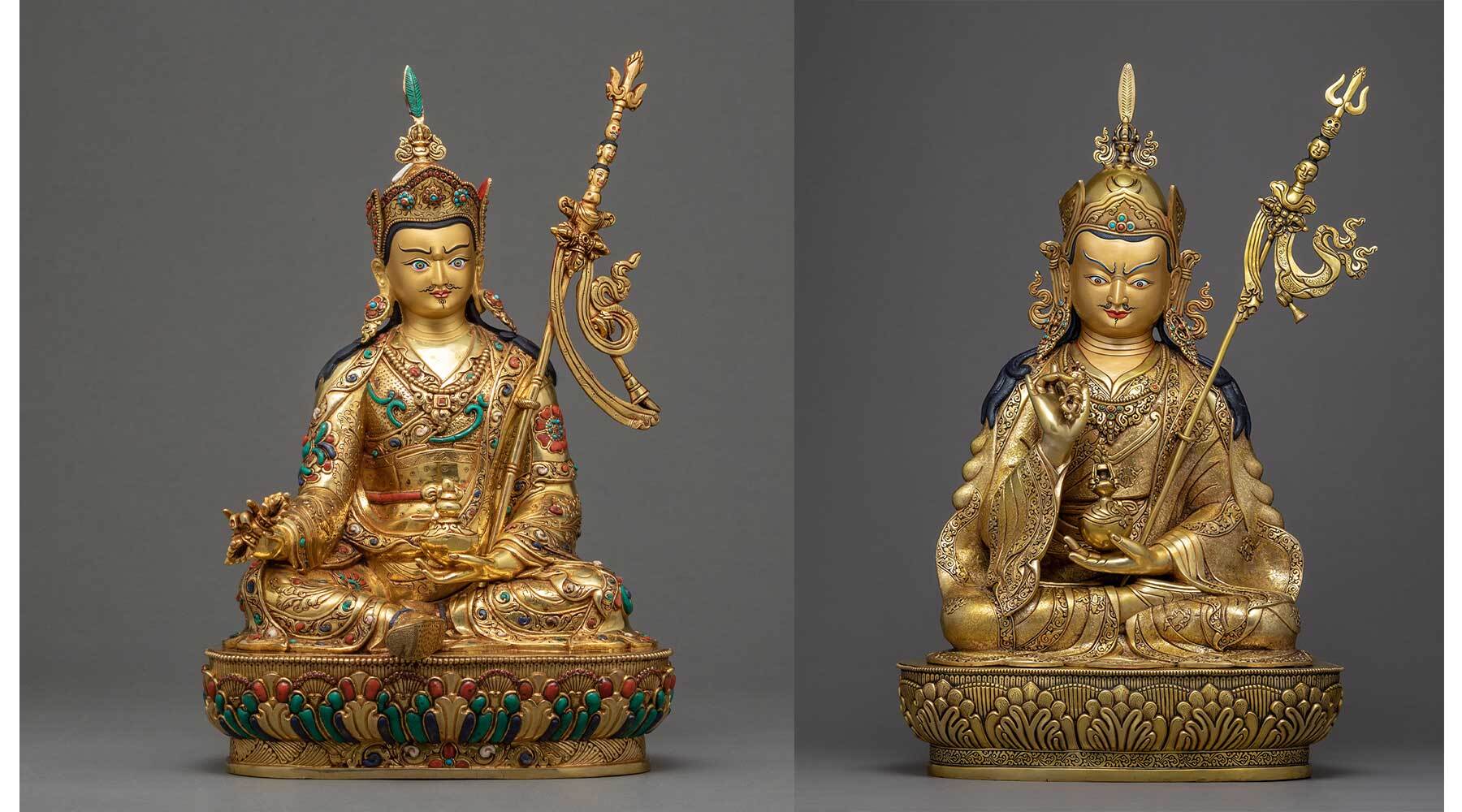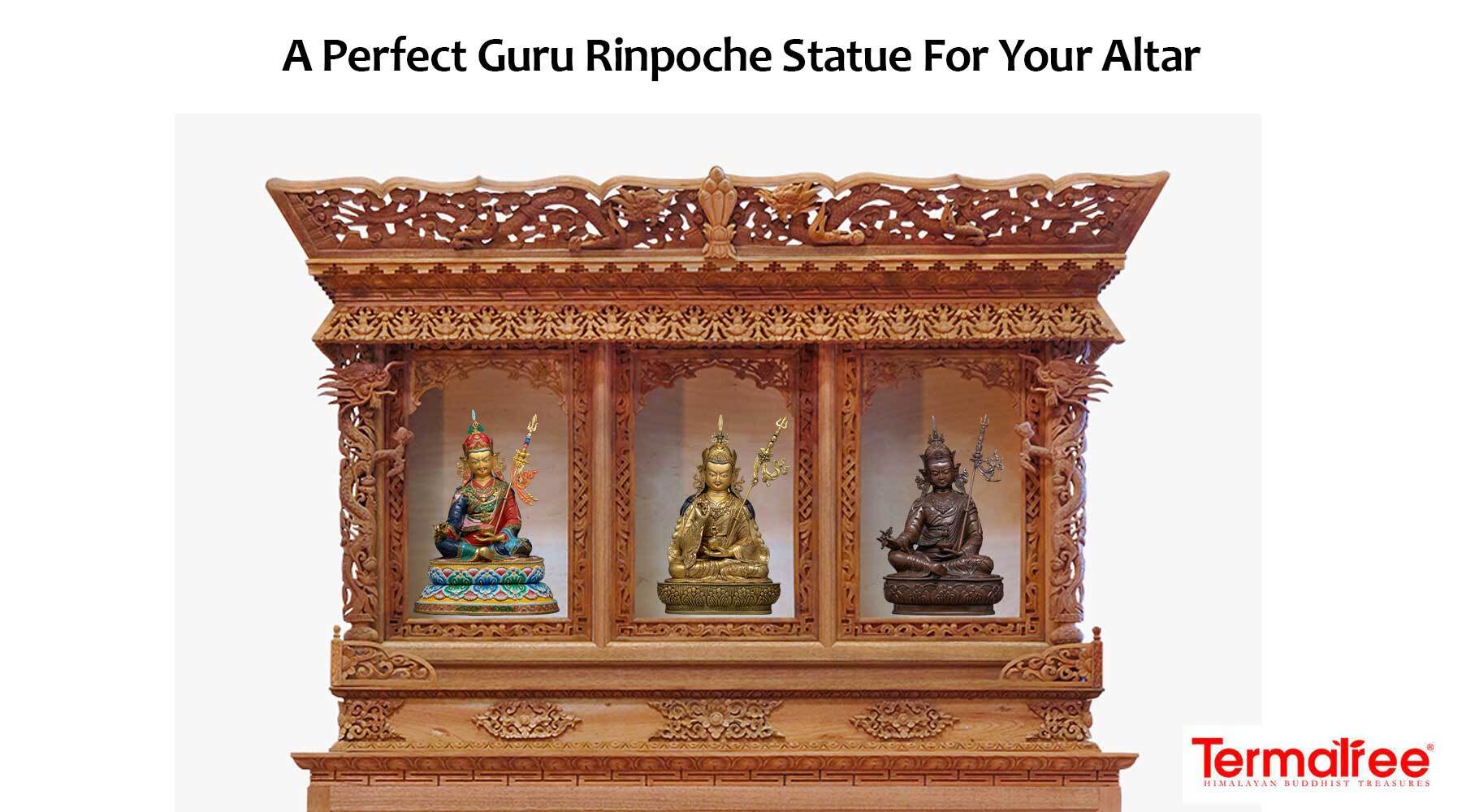Guru Rinpoche Iconography as Depicted in Statues
We, the craftsmen of Nepal, have been crafting the statues of Buddhist deities for centuries. At the same time, we are improving and perfecting the art of sculpting the deities' statues with flawless depictions with the best materials for practitioners like yourselves. The statues that are crafted in our studio represent the history and the meaning that the deity represents in the sculptures. With the skills set passed down from generation to generation, we make statues of Buddhist deities that meet the expectations of all practitioners with the perfect details and statues. When choosing a sculpture, the statue's size, iconography, and finish can make a difference in choosing the right type of statue.
Placing statues of Guru Rinpoche throughout your house can encourage peace, positive energy, health, and prosperity. They are able to create the cause of our happiness as a result, and it is through this that we experience joy all the way up to the satisfaction of enlightenment. There is a reason for making holy objects; it is because the existence of such things is necessary for the temporary and ultimate happiness of yourself and others.
Representation of Guru Rinpoche
Guru Rinpoche, also known as Padmasambhava (the Lotus Born), people often considered the second Buddha. The Vajrayana tradition—as it is currently known—continues to exist and flourish thanks to the teachings of Guru Rinpoche that he brought to Tibet during his lifetime. This is one of the explanations for Guru Rinpoche's other moniker, "Second Buddha." Often depicted at the center of the lotus flower, he is said to have been born from a lotus flower, having attained enlightenment before he was born.
During the 9th century, he visited Tibet with the invitation of the king Trisong Duetsen and is considered the first time the Buddha entered the Tibetan country. Guru Rinpoche was the key reason for the spread of Buddhism in Tibet. He also built the first Buddhist monastery in Tibet, which is located at Samye, which he achieved through feats that no ordinary human could do. We describe the eighth-century monk's significance and contributions through the use of multiple figures and sculptures.
Types of Statues
The different statues that are created in our workshop reflect a variety of Buddhist deities and the artistic vision of the creators. With numerous deities, there are various statues of each deity, which can be distinguished by their body posture, their mudras, or the material they are made from. Only the purest materials, such as pure gold and pure copper, are used to create the statues in our collection, and only master artisans from Nepal provide the fine details.
We have different types of deity statues that vary in size and weight. Larger sculptures that are placed in shrines and on altars consist of 20 kg to 40 kg and measure 70 cm to 100 cm. Slightly smaller statues, which are generally used for meditational practices and home decor, vary from 5 kg to 20 kg and measure from 30 cm to 60 cm. Miniature statues that weigh under 1 kg and measure less than 15 cm are made for people who prefer to carry their statues along with them. You can use this statue as per your desire or need.
Seated Statues of Guru Rinpoche
The statues that are crafted by our artists mainly consist of deities in their meditative position. Guru Rinpoche is seen seated at the center of a moon disc lotus. This is due to the prophecy of Gautam Buddha of a second Buddha's emergence from a lotus flower. It is also believed that when he was born, he emerged as an eight-year-old from a lotus flower while claiming to have achieved enlightenment. The different states of Guru Rinpoche have different meanings and symbolizations, which vary according to the different types of mudras that the hand is making or the religious items that he holds. Each statue of Guru Rinpoche features a unique expression representing the statue's intended use.

Click here to view our Guru Rinpoche Statue Collection
Standing Guru Rinpoche Statues
Guru Rinpoche is standing atop his lotus, which represents the great teacher. His long Tantric staff rests alongside his shoulder, where the artists have depicted the victory banners, with the heads representing Guru Rinpoche's liberation from the three kayas, desire, form, and formlessness, symbolizing the Dharmakaya, Sambhogakaya, and Nirmanakaya. Royal robes covering his body have been executively carved. In the standing depiction of the statue, the deity holds a vajra in his right hand, which is folded and pointed towards the sky. This magnificent statue of the Guru Rinpoche stands over 83 cm tall and has a weight of 15.910 kg, which can be used on temple altars. This one-of-a-kind statue takes the artist months to complete, which represents the importance the sculpture brings.
Click here to view Standing Guru Rinpoche Statue
Throne Statues
Thrones are often depicted with statues to show their royalty, symbolism, and power. Guru Rinpoche was not often represented in human form by early Buddhist artists. They preferred to suggest his presence through symbols and sometimes with the use of thrones. The artists handcraft the throne piece individually, apart from the deity, to provide the most details and add details that depict the symbolism of the deity. The lion-supported throne is placed under the lotus flower, over which the deity is seated. These statues were carved from bronze and gold materials. Due to the carvings of the throne being unique to these kinds of statues that are exclusively made in Nepal, this statue is very uncommon to see. Numerous mythical creatures that are uniquely carved by Nepalese artists are depicted on the throne. This one-of-a-kind statue of the Guru Rinpoche seated upon a throne stands 43 cm tall and weighs five and a half kilograms. 
Click here to view the Sculpture of Guru Rinpoche
Miniature Guru Rinpoche Statue
Most smaller statues are crafted using machines with similar materials and can have many variants. With the help of machines, statues are carved, and the paint is traditionally done by hand. Gold and silver plating are often used in these statues. The miniature size of the statue makes it a perfect piece that could fit on an altar or in meditational practices. Miniature statues are built from the purest of materials. These sculptures are easy to carry and can be taken from one place to another with minimal damage. The sizes of miniature statues vary from 9 cm to 20 cm, depending on the statue and the depiction the artists chose to portray. Most miniature statues have hand-painted gold or acrylic paint, which highlights the symbolism of the statue. The statue portrayed below stands over 9 cm tall, weighing 0.148 kilograms, is hand painted with 24k gold on the face and then plated with silver over the body. 
click here to view Miniature Guru Rinpoche Statue
Oxidized Copper Guru Rinpoche Statue
Copper statues are created to capture the essence of the antique touch that the use of oxidized copper provides. The oxidized copper used in the statues is traditionally crafted by hand, while some of the statues carry the painting or gilding of gold to highlight the symbolism of the statue. This statue of the Guru Rinpoche stands 55 cm tall, has a weight of 3.45 kilograms, and is made of the best materials available. With his three-pronged tantric staff resting on his shoulder while he holds a vajra with his right hand upon his right lap. 
Click here to view our Oxidized Copper Guru Rinpoche
Acrylic-painted Guru Rinpoche statue.
Of the many types of statues that are presented, the statues that are completely painted with acrylic paint stand out the most from the other statues. Acrylic paint is applied to the statue after the molding process takes place above the gilded gold statue, giving them brighter detail. Every statue that is produced in our studio is painted in acrylic paint, with a few exceptions. The statue is painted by first moistening the paint with water to make it adhere more to the concrete and then painting upward from the bottom. After that, a layer of acrylic latex is applied to the paint and let out to dry to finish the process. The statue is seen at the height of 76 cm and weighs 29.118 kilograms. It is fully covered in acrylic paint, which highlights every detail of the statue, from the most miniature detail to the regal attire that he wears. 
Click here to view Guru Padmasambhava Statue




